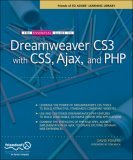Summary: a complete course
★★★★★ The Essential Guide to Dreamweaver CS3 with CSS, Ajax, and PHP by David Powers is from Friends of ED (2007). The book is a replacement for Powers’ earlier book, Foundation PHP for Dreamweaver 8, but largely revised, rewritten, and with new chapters. The new Spry widgets in CS3 are covered in several chapters.
I very much like the approach taken to most topics in this book. The author takes a look at the underlying XHTML, talks about how to keep things accessible, and warns you when things are not best practice, or still in development (as a number of the Spry widgets are) or just plain a bad idea.
As you could gather from the title, there is more to this book than just a run through the ways you use Dreamweaver to put text on a page. You find out how to set up for PHP, how to install a MySQL database, and how to use phpMyAdmin.
In the CSS chapter, Powers supports concepts I’ve preached for quite some time, such as to stay away from the Property inspector for fonts. There is a whole chapter on modifiying one of the built-in CSS layouts that are included in Dreamweaver CS3.
There are several chapters dealing with data, data tables, data access, searching data.
This is a very complete, helpful book to anyone who wants to learn more about Dreamweaver CS3 and use it to maintain dynamic, database driven sites. It is not for the complete novice with Dreamweaver.
If I were teaching a Dreamweaver course on a level that included working with databases, I would be quite happy to use this book. It’s thorough, it supports standards and best practices, and it’s clearly written.
Technorati Tags: Book Review, Dreamweaver CS3 with CSS, Ajax, and PHP

